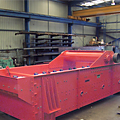MAXIMIZING PRODUCTION WITH AN EFFICIENT GRIZZLY SETUP
November 24, 2014
Having already addressed contrasting grizzly feeders, we can quickly conclude that these mechanisms are essential in the regulation of large chunks of rock. Placed at the critical start point of a long grading process, a grizzly sets important factors with brute strength, acting as a key coordinator for everything from capacity to the initial size of conveyed matter.
Improving the efficiency of what is already a remarkably integrated process isn’t as challenging as one would guess. Introduce a hiFeed vibrating grizzly or an extra heavy duty vibrating alternative, pairing precision craftsmanship with an ISO 9001 environment to raise productivity. Here are some tips.
INCORPORATE STEP-DECK CONFIGURATION
Increase capacity and flow speed without sacrificing reliability. The addition of a step-deck configuration sends tough rocks and ore through two or more sets of grizzly bars to provide a significant increase in screen coverage. Additionally, the greater distribution of the bars delivers smarter operation to a brute force process, easing the load on strained bearings and minimizing down-time as a result of maintenance. In short, spread the rugged load and enjoy the benefits thanks to step-deck utilization.
BARS VS. PERFORATED PLATE
The accepted way of managing destructive feeds is to rely on heavy-duty steel bars, vibrating the matter to separate fines and crush large lumps. Now, thanks to the forging of metal and the implementation of engineering principles, the feed stage sees the introduction of 4-inch thick rugged metal plates with sized apertures as an alternative to the standard grizzly. Not yet a threat to the dominance of the established grizzly form and shape, this is one example of breaking out of the box to adapt new technology. The 4 bearing system uses an eccentric shaft assembly to minimize destructive vibrations and improve screening.
CUSTOMIZED GRIZZLY DESIGN
The grizzly is the backbone of a mining operation, a quarrying process, or even a recycling setup. Tailor the equipment for the process. Fit A-R liners to absorb impact from heavier matter, adjusting the counter-balances on the feeder vibratory assembly to adjust the length of the feed stroke. Plasticity of the material and the flow characteristics of the feed rate are just some of the criteria to account for in this calculation.
Screening Technology Pty Ltd T/AS Hawk Machinery
Address: 7 Lantana St Blackburn North Vic 3130
Contact Person: Bohdan Blaszczyk
Phone: +61 3 9877 7777
Fax: +61 3 9877 8177
Mobile: 0411 099 989
Email: info@hawkmachinery.com.au
Optimized by NetwizardSEO.com.au
Optimized by: Netwizard SEO


